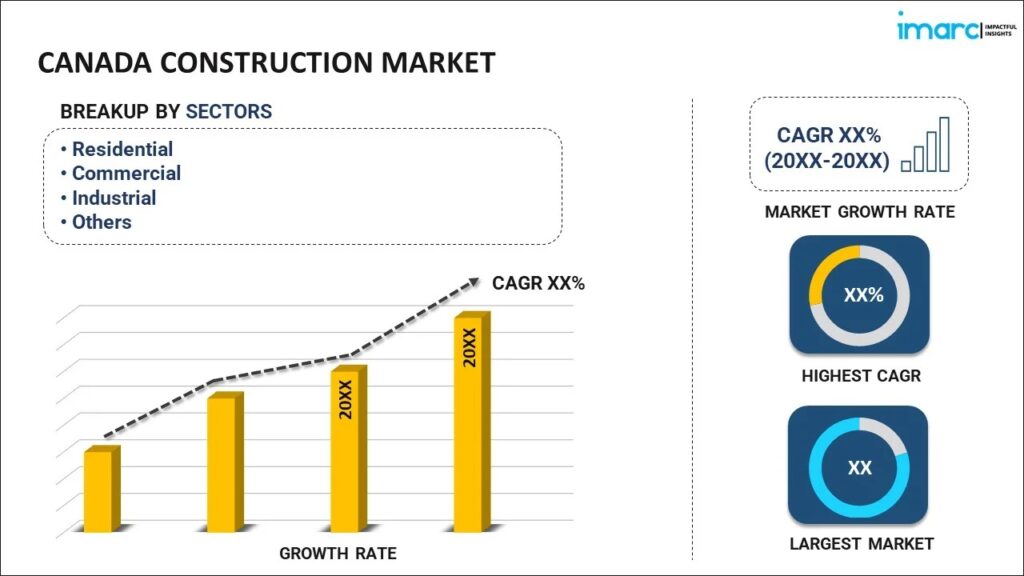
Canada Construction Output Falls 1.8% in 2024 Amid Residential Sector Slowdown
The Canadian construction industry has experienced a 1.8% decline in real terms for 2024, largely due to a prolonged slowdown in the residential construction sector. This downturn has been caused by a combination of factors, including high construction costs, labor shortages, rising household debt, decreased housing demand, and delays in regulatory processes. These challenges have weighed heavily on the overall performance of the industry.
Residential Sector Struggles
The residential construction market has been one of the hardest-hit areas. According to Statistics Canada, the total value of investment in single-dwelling construction dropped by 4.4% year-on-year (YoY) between January and September 2024, following a sharp decline of 17.3% in 2023. These ongoing contractions reflect a broader trend in the market, as higher construction prices, primarily driven by increased material and labor costs, continue to deter prospective homeowners and developers.
In addition to the high costs, the Canadian construction industry is grappling with significant labor shortages, which have further exacerbated the problem. These shortages have slowed project timelines and contributed to inflated wages, making construction projects less attractive financially. Rising household debt and high-interest rates have further reduced housing affordability, dampening demand and causing a slowdown in new residential construction projects.
Declining Employment and Permits
Construction employment in Canada has also faced a slight decrease. The sector saw a 0.3% reduction in jobs during the first 11 months of 2024, reversing a positive trend from 2023. In that year, a 1.9% increase in construction employment had been fueled by high immigration levels. However, as the industry continues to contract, the demand for labor has softened. Furthermore, the number of building permits issued has fallen, signaling a lack of new construction activity. The value of building permits dropped by 0.7% between January and September 2024, following a 7% decline in 2023.

These trends are part of a broader economic slowdown in Canada, where low business confidence and high-interest rates have dampened overall growth. The country has experienced a slow recovery as interest rates remained elevated throughout the year, contributing to lower demand for both residential and commercial construction projects.
The Broader Economic Context
The slowdown in the construction industry is emblematic of wider economic struggles in Canada. The Bank of Canada’s decision to maintain high-interest rates throughout much of 2024 has had significant ripple effects, affecting business investment and consumer spending. As borrowing costs remained high, economic growth slowed, and many businesses chose to hold off on expansion plans or major projects, further depressing construction activity.
However, the situation is expected to improve. After several rounds of interest rate cuts throughout 2024, including a notable 50 basis point (BPS) reduction in December that brought the Bank of Canada’s rate to 3.25%, analysts are forecasting a rebound in 2025. Lower interest rates should encourage greater demand across multiple sectors, including construction, as financing becomes more affordable for both businesses and consumers.
Recovery Projections and Future Outlook
Looking ahead, analysts predict a modest recovery for the Canadian construction industry, with an annual growth rate of 2.8% from 2025 to 2028. This recovery will be supported by increased investments in several key areas, including transportation, renewable energy, and water and sewage infrastructure. These sectors are expected to drive demand, with government projects playing a crucial role.
For instance, the government of Ontario has announced an ambitious CAD 28 billion ($21 billion) investment in infrastructure projects, including road repairs, construction, and expansion of highways. These initiatives, combined with growing demand for renewable energy and improved infrastructure, will help foster a more positive outlook for the industry over the next few years.
Key Segments of the Canadian Construction Market
The Canadian construction industry is divided into several key segments, each of which has been impacted differently by the challenges of 2024:
- Commercial Construction: The commercial construction sector has experienced a slowdown, with fewer new office buildings and retail spaces being developed. However, there is growing demand for warehousing and logistics infrastructure, driven by the ongoing rise of e-commerce.
- Industrial Construction: The industrial sector has also faced challenges, but investments in manufacturing facilities, particularly in the automotive and tech industries, are expected to support moderate growth.
- Infrastructure Construction: As mentioned earlier, major infrastructure projects, including roads, bridges, and renewable energy installations, are expected to drive recovery in this segment. Government spending on these projects will be a key driver.
- Energy and Utilities: This sector is set for growth, particularly in renewable energy projects such as wind, solar, and hydropower, which have received substantial government support.
- Institutional Construction: Healthcare and educational facilities are expected to continue receiving investments, especially in the wake of the COVID-19 pandemic, which highlighted the need for improved infrastructure in these areas.
- Residential Construction: The residential sector is likely to remain subdued in the short term, but a gradual rebound is expected as housing affordability improves with lower interest rates and more favorable economic conditions.
Conclusion
In conclusion, the Canadian construction industry is currently navigating through a period of contraction, primarily due to the ongoing slowdown in residential construction. Despite this, the outlook for the sector is positive, with a projected recovery beginning in 2025. Increased investments in infrastructure, energy, and other key sectors are expected to drive growth over the coming years. With interest rates coming down and a stabilizing economy, the Canadian construction industry is poised for a gradual recovery, offering opportunities for businesses and investors in the medium term.
Key Topics to Consider
- Economic performance of the Canadian construction industry
- Forecasting and market opportunities
- Breakdown of key sectors and sub-sectors
- Key industry participants and contractors
- Analysis of major construction projects and development pipelines




